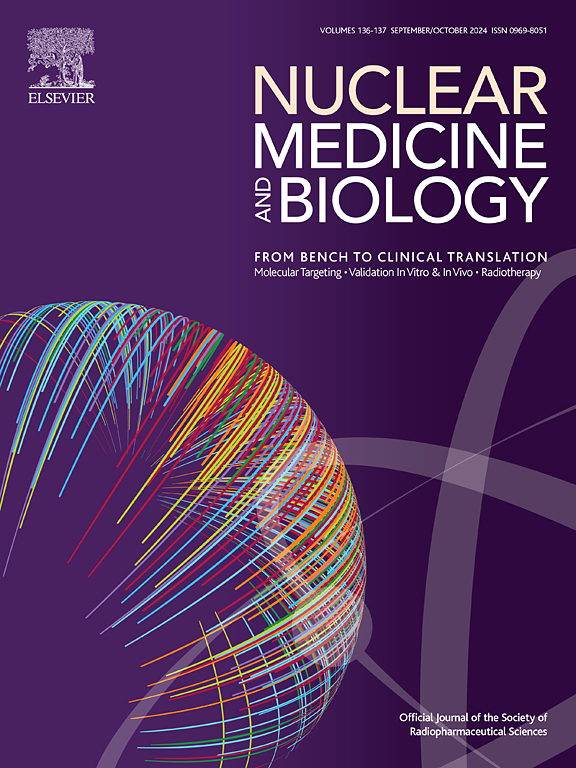Application of [99mTc]Tc-GSA in the diagnosis of Staphylococcus aureus infections
IF 3.6
4区 医学
Q1 RADIOLOGY, NUCLEAR MEDICINE & MEDICAL IMAGING
引用次数: 0
Abstract
Introduction
Staphylococcus aureus can cause a variety of conditions such as bacteremia, sepsis, toxic shock syndrome, pneumonia, and infective endocarditis; therefore, a rapid and accurate diagnosis should be made to pinpoint the site of infection. This study aimed to use the existing nuclear medicine tracer [99mTc]Tc-dimercaptosuccinic acid galactosyl human serum albumin ([99mTc]Tc-GSA) as a simple technique for the early diagnosis of S. aureus infection.
Methods
The in vitro studies evaluated the accumulation of [99mTc]Tc-GSA in S. aureus. In addition, the effect of metabolic and vital activity and inhibition of asialoglycoprotein receptors on [99mTc]Tc-GSA accumulation were evaluated. In vivo studies were performed on the biodistribution and imaging of [99mTc]Tc-GSA in the S. aureus SR3637 mouse thigh infection model.
Results
In vitro studies have confirmed that [99mTc]Tc-GSA accumulates to the same extent as 2-deoxy-2-[18F]fluoro-d-glucose, and it was thought that [99mTc]Tc-GSA binds to the receptors that recognize the saccharide molecules and glycan chains expressed in S. aureus. In addition, in the distribution and imaging of [99mTc]Tc-GSA, it was confirmed that the latter accumulates at the infection site and shows a clear contrast with the non-infected site.
Conclusion
The application of [99mTc]Tc-GSA to the imaging diagnosis of S. aureus infection is expected to non-invasively detect the localization of S. aureus in real time, pinpoint the site of infection and determine the number of viable bacteria, and help in the selection of optimal therapeutic agents and treatments.

[99mTc]Tc-GSA在金黄色葡萄球菌感染诊断中的应用
金黄色葡萄球菌可引起多种疾病,如菌血症、败血症、中毒性休克综合征、肺炎和感染性心内膜炎;因此,应迅速而准确地诊断以查明感染部位。本研究旨在利用现有的核医学示踪剂[99mTc] tc -二巯基琥珀酸半乳糖人血清白蛋白([99mTc]Tc-GSA)作为早期诊断金黄色葡萄球菌感染的简单技术。方法体外研究[99mTc]Tc-GSA在金黄色葡萄球菌中的积累情况。此外,我们还评估了代谢和生命活性以及asialal糖蛋白受体抑制对[99mTc]Tc-GSA积累的影响。对[99mTc]Tc-GSA在金黄色葡萄球菌SR3637小鼠大腿感染模型中的生物分布和成像进行了体内研究。结果体外研究证实[99mTc]Tc-GSA的积累程度与2-脱氧-2-[18F]氟葡萄糖相同,认为[99mTc]Tc-GSA与在金黄色葡萄球菌中表达的识别糖分子和聚糖链的受体结合。此外,在[99mTc]Tc-GSA的分布和成像中,证实后者在感染部位聚集,与未感染部位形成明显对比。结论将[99mTc]Tc-GSA应用于金黄色葡萄球菌感染的影像学诊断,有望实时无创检测金黄色葡萄球菌的定位,准确定位感染部位并确定活菌数量,帮助选择最佳的治疗药物和治疗方法。
本文章由计算机程序翻译,如有差异,请以英文原文为准。
求助全文
约1分钟内获得全文
求助全文
来源期刊

Nuclear medicine and biology
医学-核医学
CiteScore
6.00
自引率
9.70%
发文量
479
审稿时长
51 days
期刊介绍:
Nuclear Medicine and Biology publishes original research addressing all aspects of radiopharmaceutical science: synthesis, in vitro and ex vivo studies, in vivo biodistribution by dissection or imaging, radiopharmacology, radiopharmacy, and translational clinical studies of new targeted radiotracers. The importance of the target to an unmet clinical need should be the first consideration. If the synthesis of a new radiopharmaceutical is submitted without in vitro or in vivo data, then the uniqueness of the chemistry must be emphasized.
These multidisciplinary studies should validate the mechanism of localization whether the probe is based on binding to a receptor, enzyme, tumor antigen, or another well-defined target. The studies should be aimed at evaluating how the chemical and radiopharmaceutical properties affect pharmacokinetics, pharmacodynamics, or therapeutic efficacy. Ideally, the study would address the sensitivity of the probe to changes in disease or treatment, although studies validating mechanism alone are acceptable. Radiopharmacy practice, addressing the issues of preparation, automation, quality control, dispensing, and regulations applicable to qualification and administration of radiopharmaceuticals to humans, is an important aspect of the developmental process, but only if the study has a significant impact on the field.
Contributions on the subject of therapeutic radiopharmaceuticals also are appropriate provided that the specificity of labeled compound localization and therapeutic effect have been addressed.
 求助内容:
求助内容: 应助结果提醒方式:
应助结果提醒方式:


